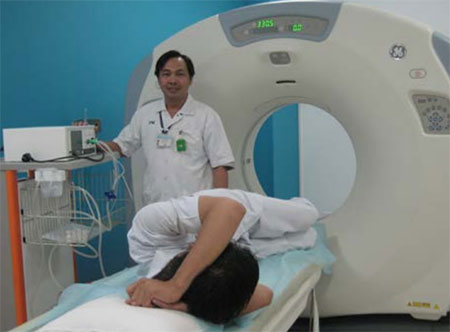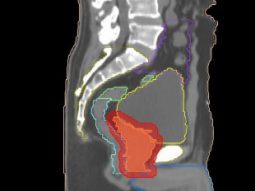WHAT IS A VIRTUAL COLONOSCOPY?
Virtual colonoscopy, also called CT colonography, is a method of screening the colon for precancerous polyps using a CT scanner. CT scanning is a non-invasive medical test that combines special x-ray equipment with sophisticated computers to produce multiple images of the inside of the body. CT colonography provides an interior view of the colon (the large intestine) without a colonoscope and without sedation.
WHAT ARE THE COMMON USES OF THE PROCEDURE?
The major reason for performing CT colonography is to screen for polyps or cancers in the large intestine. Polyps are growths that arise from the inner lining of the intestine. Some polyps may grow and turn into cancers.

The goal of screening with colonography is to find these growths in their early stages, so that they can be removed before cancer has had a chance to develop. For the early detection of colorectal cancer, the American Cancer Society recommends that, beginning at age 50, both men and women should follow one of these testing schedules:
- Flexible sigmoidoscopy every 5 years, or
- Colonoscopy every 10 years, or
- CT colonography (virtual colonoscopy) every 5 years.
Individuals at increased risk or with a family history of colon cancer may start screening at age 40 or younger and may be screened at shorter intervals (for example, every five years). Risk factors for the disease include a history of polyps, a family history of colon cancer, or the presence of blood in the stool.
HOW SHOULD I PREPARE FOR THE PROCEDURE?
You will be required, before your exam, to fill a questionnaire form and you will be given a bowel preparation instruction sheet at the time you schedule your appointment. You will be asked to take a low-fibre diet and a laxative liquid. It is very important to clean out your colon the night before your CT colonography examination so that the radiologist can clearly see any polyps that might be present. Additional agents may also be taken the day before the exam. These may include small quantities of diluted iodinated contrast media to mark the remaining stools or liquid.
Be sure to inform your doctor if you have heart, liver or kidney disease to be certain that the bowel preparation will be safe.
The day of the exam, you will be asked to remove your clothes and to wear a gown. You may also be asked to remove jewellery and any metal objects or clothing that might interfere with the x-ray transmission.
Women should always inform their doctor, the radiologist or the diagnostic radiographer if there is any possibility that they are pregnant.
HOW IS THE PROCEDURE PERFORMED?
The diagnostic radiographer begins by positioning you on the CT examination table, usually lying flat on your back or possibly on your side or on your stomach. Straps and pillows may be used to help you maintain the correct position and to hold still during the exam. The whole process takes just 15 to 20 minutes.
Carbon dioxide gas is gently pumped automatically into your large bowel via a rectal tube (about five centimetres in length) to distend the colon so that good image quality is obtained. Then, CT scanning is performed in supine and prone position. You will be asked to hold your breath during image acquisition. Once the scans are completed, the rectal tube is removed.

WHAT ARE THE DIFFERENCES BETWEEN VIRTUAL COLONOSCOPY AND A TRADITIONAL (OPTICAL) COLONOSCOPY?
| Virtual colonoscopy | Traditional colonoscopy | |
| Tube | Small tube (about 5 cm in length) | Endoscopy tube (180 cm in length) |
| Risks | Rare | Few |
| Time | 15 to 20 minutes | Around 30 minutes |
| Anaesthesia | No | Required |
| Downtime(Time the patient should stop his/her usual daily activities) | No | One day |
| Treatment while having test | No | Biopsy or polyp removal |
| Radiation | Low dose | No |
WHAT ARE THE ADVANTAGES OF UNDERGOING VIRTUAL COLONOSCOPY AT FV HOSPITAL?
FV Hospital’s virtual colonoscopy is performed in strict alignment with international standards and procedures. The carbon dioxide (CO2) used for distending the bowel is delivered safely through an automatic pump. Since CO2 is absorbed faster than air (when a manual pump is used), the procedure is more comfortable for the patient. Immediately after the procedure has been completed, you can return to work or go home, and drive yourself if you wish.
WHAT ARE THE RISKS AND BENEFITS?
Risks
- There is a very small risk that inflating the colon with air or carbon dioxide could injure or perforate the bowel. This has been estimated to happen in less than one in 10,000 patients.
- The effective radiation dose from this procedure is about 10 mSv, which is about the same as the average person receives from background radiation in 3 years.
- CT scanning is, in general, not recommended for pregnant women.
Benefits
- This new minimally invasive test provides three-dimensional images that can depict many polyps and other lesions as clearly as when they are directly seen by optical colonoscopy.
- The risk of perforating the colon is markedly lower than optical colonoscopy.
- CT colonography is an excellent alternative for patients who have clinical factors that increase the risk of complications from colonoscopy, such as elderly patients or under treatment with a blood thinner or a severe breathing problem.
- CT colonography can be helpful when optical colonoscopy cannot be completed because the bowel is narrowed or obstructed for any reason, such as by a large tumour or if optical colonoscopy cannot reach the full length of the colon, which occurs up to 10 percent of the time.
- CT colonography is tolerated well. Sedation and pain-relievers are not needed, so the patient can return home right after the procedure, including driving.
WHAT ARE THE LIMITATIONS OF A VIRTUAL COLONOSCOPY?
- CT colonography is not as good as optical colonoscopy for smaller polyps. Fortunately, these smaller polyps are either noncancerous or benign.
- Biopsy can only be performed via an optical colonoscopy to differentiate a benign and a precancerous polyp.
- If an abnormality is detected on a CT colonography, the patient will need a traditional colonoscopy to remove the polyp or the tumour and to determine its nature.
HOW ABOUT THE RESULTS
Your examination will be reviewed and reported by a radiologist.
You will receive a formal written report on the same day or within two (2) days depending on your clinical and diagnostic requirements.

 Vi
Vi 












